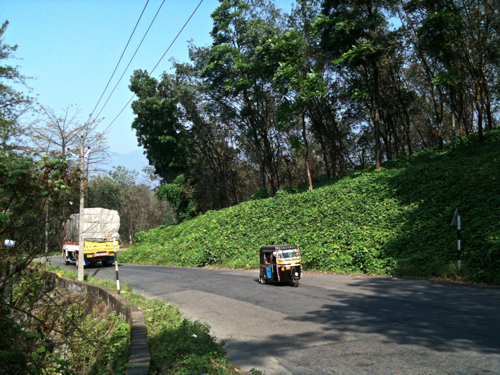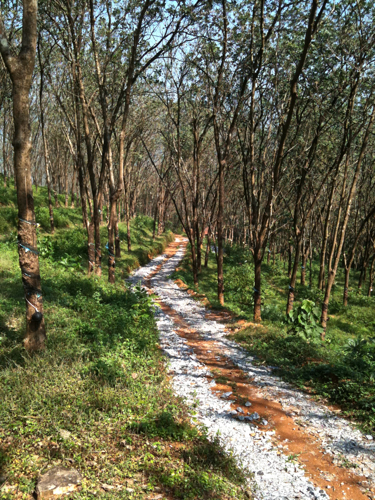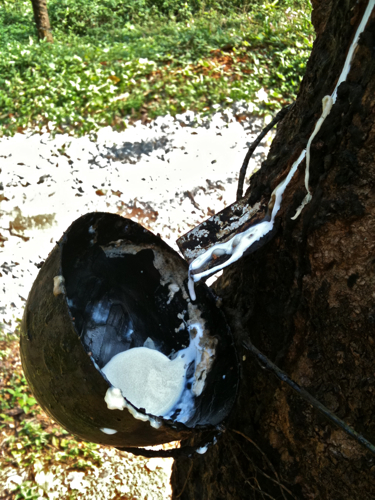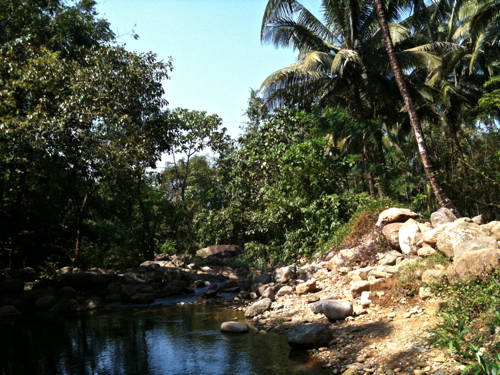On the drive back from the hills of Vayannad, where we’d spent four restful days at a homestay, our vehicle – a Toyota Qualis – broke down. Someone passing by noticed smoke below our car; we stopped immediately. After a cursory look behind the wheels followed by a lengthy consultation on his mobile phone, our driver announced it was a “bearing problem in the brake system”. A replacement was on its way from Calicut, the nearest city. It would take an hour to reach the spot we were stranded in.
The road cut through the hillside. Above and below us rubber plantations ran as far as the eye could see. Traffic was moderate; we decided to picnic on the spot. (An outcome unimaginable back in Germany.) After a few helpings of obbuttus, kodu-bales, chakkalis and banana chips I felt like a walk through the rubber plantation.
A hundred metres or so down the road there was a break in the plantation wall. The spot also seemed to be a makeshift bus-stop: a group had gathered there, and every now and then someone would wave down a bus and climb in. When I reached the opening a man stopped me. He was of medium height, dressed in a pale-yellow shirt over a white mundu. Most people dressed this way in these parts; it was not easy to gather the status of a man from his dress. (Some days previously, at the homestay, I had mistaken the owner for a driver; later I learned that he owned and managed 50 acres of plantations.)
“Where do you think you are going?” he asked, in Malayalam.
In Europe, upon encountering the vernacular, my first instinct is to attempt a switch to English: Sprechen Sie Englisch? Parle Anglais? I was tempted to do the same here – English ariyamo?! – but I checked myself. Hindi seemed a more sensible option.
“Walk – ek walk le sakthe hain?” May I take a walk?
“Where are you from?” he asked, switching suddenly to English.
“Ah, you speak English. I’m from Bangalore. Can I take a walk here?”
He looked at me curiously, up and down, perhaps checking if I was carrying anything. (I only had an iPhone in my hand.)
“Walk only? Yes, yes.” He waved me in.
A small path led down the hill. On both sides, at regular intervals, rows of rubber trees fanned out in arcs along the hillside. Each tree had an incision tracing a curve around its trunk, as if someone had cut into the surface with a sharp instrument. The sap, a milky liquid originating from the tree bark, appeared along the length of this incision and collected into a plastic cup (and not, as I had seen previously, into a coconut shell). The substance in the cup was soft and springy, but not sticky, and strange enough, it felt unnatural: removed from its source, it could easily be mistaken for a synthetic material.
* * *
At this point, dear reader, I wanted to write a few paragraphs about the history of rubber, from the days the Mesoamericans played a rubber-ball game around 1800 BC until the recent findings on alternative sources of natural rubber. I even did all the research (you’ll see that in a moment). Then, as I struggled to construct a decent narrative out of all that material, I thought: What the heck, why should I do all the hard work while the readers have it so easy? This isn’t a magazine, it’s a blog. This is the point of web 2.0, isn’t it – the whole experience needs to be “collaborative”. It’s no longer a read-only web, it’s a “read-write web”. So involve the reader in the experience! Make her dig around for stories! Get her to write as well!
So instead of a summary, you get a collection of links. And there is some white space below where you can – after printing this post – write your own little summary of what you’ve learned. Also, you may leave comments with any additional interesting information you found on this topic. (So you can now even tell your mother – or spouse – that you are not wasting time “surfing” the web: you are doing research, you are practicing exposition skills, and you are indulging in team-work.) Alright then, here is the list:
Rubber history for Dummies
- If you are one of those lazy/busy ones and want a quick overview, this charming and funny video is perfect for you.
- For a quick-read on how Europeans discovered rubber and brought it home, read this. (The same article covers, in some detail, the contribution of Charles Goodyear to the history of rubber.)
- Another overview of the history rubber from the 18th Century until the modern times can be found here.
- A short history of synthetic rubber here.
Rubber history for Enthusiasts
- A concise history of natural rubber.
- A (jargon-filled) history of the synthetic rubber industry.
- Another article of Charles Goodyear and his discovery of the Vulcanization process. (A bit cheesy, not surprising given it was first published in Reader’s Digest.)
Rubber history for Academics
- The one-stop shop on everything about rubber, Bouncing-Balls.com has some fascinating material. Its author is a chemist who has spent decades in the rubber industry, lectured on it, and has even written a book.
- Fascinating new research that indicates another potential source of natural rubber: Dandelions!
Rubber history for Geeks
- Explore rubber history through the Google Wonder Wheel or the Google Timeline view.
Rubber history for Connoisseurs
- If you have access to the full online archive of The New Yorker, you can reach into a treasure trove that even Google cannot mine. I found a charming article – from the 26th August, 1950 edition – about Silly Putty, that begins like this: “We went into the Doubleday bookshop at Fifth Avenue and Fifty-second Street the other day, intending, in our innocence, to buy a book, and found all the clerks busy selling Silly Putty, a gooey, pinkish, repellent-looking commodity that comes in plastic containers the size and shape of eggs.”
That was the rubber story. It’s now time to get back to the excursion story. But before that, here is that space where you can jot down your summary…
* * *
I was still examining the texture of latex in the bowl when I heard voices ahead. Two men were walking from tree to tree, making incisions using a marker. I approached them with a request: could I take a video? They nodded.
I followed the man’s hint and continued downhill, towards the “falls”. Along the way a group of squatting women – rubber tappers taking a break? – paused their chatter and watched me walk past. Once again I had to curb my small-town-European instinct of greeting passersby on a walk through the woods. (The next instant I regretted it: given how surprised they were to see a trespasser in the plantation, it may have been worth watching their reaction as I smiled, nodded and said “Hello”.)
The gush of water, not too far away, felt pleasing to the ears; I walked in its direction. Soon the path flattened and entered a coconut grove. An old cottage lay to one side. Although there were signs of life – clothes on the line, freshly chopped wood – I could not see anyone. Ahead, at the edge of the grove, was a mountain stream.
The stream, though small, rushed powerfully over the small rocks and pebbles and collected in a shallow pool before surging further. It was a secluded spot, a hidden gem, tucked away in the mountains, far from the crowds hungry for such exotic spots. How many of these are left, I wondered, as I started back up the hill after a few restful minutes.
Back at the car the new bearings had arrived – in another car, this time a Toyota Innova – but no one was doing anything with it. “We are waiting for the car-mechanic,” explained our driver. “He’s from a nearby town, and is coming here in an auto.” It was past lunch-time. We decided to leave for Calicut in the Innova and asked our driver to pick us up later.
We reached Calicut in less than an hour. There were no further adventures. Don’t believe a word of what they tell you about Toyotas and their malfunctioning parts – it’s all a lie. When it isn’t, when a Toyota really breaks down, take a walk, explore the neighbourhood, and once you are back, write about it.





That was truly, truly EVIL.
Fortunately, Discovery Channel is airing a show on rubber next week, I shall watch that, so there!
Bunny
Well, I’m expecting a summary comment here after you watch that documentary.
Cool descriptrion dude … Wish u cud have completed it.. Aadha hai ..
Wayanad is one of few places where nature has been left on its own !!!!
You are right, Ashwin – it was stuck within me for too long, and I had to get it out, even if incomplete.
In the spirit of the post’s premise, I’m tempted to reply: Aadha hai, poora kar dijiye na 🙂
hahaha…nobody’s going to write that summary!!
bips
Forget the summary Bips, hardly anyone has even clicked on the links! Lazy, lazy people.
Very nice experience indeed. Especially how you turned a frustrating, hot wait into something so pleasurable. Liked the dig at Toyota too 🙂 But in India, Honda is the standard in quality levels.
I’ve been a lurker on all blogs that I read. Usually, I comment with a pseudonym, i.e., as somebody else! But this time, I have to sign in because I liked how you tried to get your readers to do research (I did not do it though!). About a couple of years ago, something similar happened to me when I was writing out a complete description, then realized that I was just re-describing the wheel 😉 – and ended up providing a link instead.
– Porcupyn
You know, silly putty is the only link I clicked (after sighing wistfully at the New Yorker and promising myself a subscription) and I guess you know the reason. Some of the links were damn interesting for that tiny bit of toy we rarely bother abt. 😀
Interesting expedition btw. Something similar happened to us in Coorg once, though it wasn’t a car breaking down but a tree blocking the road. We were stuck for a while and a helpful plantation owner asked us to take a walk in his estate while he and his boys with their machetes tried to hack off a few bits and make way. I could never think of blogging about it the way you’ve done. Wonderful!
beautiful narrative as usual. and i confess, havent clicked on the links. that’s the way we bombayites are, you know. we look at easier, quicker options and pounce on them when we find them, but till then…